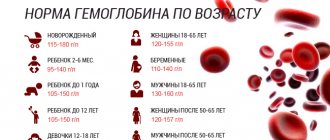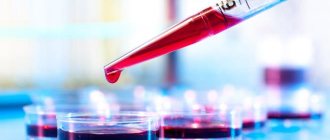Share article on social networks:
Increased ESR means decreased hemoglobin, and vice versa: ESR indicators almost always depend on the amount of hemoglobin. If iron-containing protein in the blood is increased, then the ESR always decreases. But not many patients understand the relationship between these two indicators and want to know why low hemoglobin and increased ESR are considered signs of pathology?
The erythrocyte sedimentation rate is usually measured by the height parameter (in mm) of the column, which is formed when erythrocytes settle in a special laboratory tube in one hour.
Important: the level of ESR (erythrocyte sedimentation reaction), which differs from accepted norms, is interpreted as an indirect indicator of pathological changes in protein content and immunoglobulin concentration.
Proteins that can be classified as “acute phase” are a heterogeneous group and include protease inhibitors and fibrinogen.
The body’s synthesis of “acute” proteins is a specific response of the liver to the ongoing process of inflammation. The inflammatory cytokine (interleukin-6) appears to be the most powerful mediator that stimulates the production of “acute phase” proteins in the liver.
In any condition associated with a sharp quantitative increase in “acute phase” proteins or an increase in the amount of gammaglobulins (mono- and polyclonal hypergammaglobulinemia), the erythrocyte sedimentation rate increases (due to an increase in the dielectric plasma constant), and this inevitably leads to a decrease in hemoglobin levels.
Important: low hemoglobin and ESR are interrelated, since there is a decrease in inter-erythrocyte repulsive forces, and this promotes erythrocyte aggregation, accelerating their sedimentation.
ROE may increase regardless of inflammatory processes; this condition is typical for elderly patients, pregnant women and postoperative patients.
Low hemoglobin - what does it mean?
When you have low blood hemoglobin
, it may happen that the organs will experience a lack of oxygen. Hemoglobin is an iron-containing protein found in red blood cells that binds oxygen in the lungs and transports it throughout the body. Therefore, low hemoglobin levels mean reduced oxygen delivery to tissues and organs.
Low hemoglobin values
Normal values of hemoglobin in the blood
depend on age, they are very high for newborns and decrease with age.
The values that indicate low hemoglobin are:
Please note that values may vary slightly depending on the laboratory where the test was performed. To make an accurate diagnosis, a complete blood test should be done, which, in addition to hemoglobin, includes an assessment of the number of red blood cells, leukocytes, platelets, hematocrit and other parameters that indicate the amount of iron, as well as parameters related to infections, and finally parameters of liver (transaminase) and kidney (creatinine) function. This will allow you to have a complete understanding of the situation and diagnose the cause of the decrease in hemoglobin
. For example, if a blood test indicates a tumor, a CT scan should be done to confirm its presence.
Red blood cells (RBC)
Red blood cells are “carriers” of oxygen.
The name comes from the fact that these blood cells are red in color, due to the hemoglobin they contain. Hemoglobin binds and releases oxygen at the right time thanks to the iron it contains. It is red blood cells that give blood its red tint. Oxygenated (arterial) blood is bright red; after oxygen is released, the color of the blood changes to dark red (venous blood).
How does low hemoglobin manifest?
Blood smear for anemia...
All symptoms that appear when hemoglobin decreases are associated with less oxygen reaching tissues and organs.
In particular:
- Fatigue and weakness, since the muscles, due to a lack of oxygen, are not able to withstand even minimal loads, so fatigue can manifest itself even at rest.
- Tachycardia because the heart, in an attempt to compensate for the lack of oxygen, increases the heart rate.
- Headache and dizziness caused by low oxygenation of the brain.
- Feeling cold and cooling of the arms and legs as they have vasoconstriction, which reduces blood flow to the extremities to concentrate blood supply and provide oxygen to vital organs. Vasoconstriction also causes pallor.
More serious risks of heart attack include congestive heart failure and cardiac hypertrophy.
Causes of low hemoglobin values
Causes of low hemoglobin in the blood
may not be pathological or associated with certain diseases.
Causes are non-pathological
The causes are not pathological, as well as all those situations that lead to a decrease in hemoglobin, they are transient, easily reversible and not associated with pathology.
- Athletes: Strenuous sports activities such as cycling, skiing or marathon running can lead to decreased hemoglobin values due to increased blood volume and hemodilution, which leads to a decrease in the concentration of red blood cells in the blood. This is the body's adaptive response to aerobic stress.
- Vegetarians: Those who follow a vegetarian or vegan diet without eating meat may experience a decrease in hemoglobin due to low iron intake. Iron, which is found mainly in animal products, is an essential component for the construction of hemoglobin.
- Pregnancy and childbirth: During pregnancy, a decrease in hemoglobin levels
. This depends on many factors, primarily the increased need for iron and folic acid, so they must be additionally included in the diet to prevent anemia. In addition, hemodilution due to an increase in plasma volume, but not red blood cells, leads to a decrease in the concentration of the latter and a decrease in hemoglobin values, as well as a decrease in platelets and an increase in leukocytes. - Menstruation: In women who have very heavy menstruation, which lasts more than 4-5 days, a decrease in the level of iron, red blood cells and hemoglobin can be observed, as a result of massive blood loss.
- Older people: As we age, there is a physiological decline in hemoglobin levels associated with less production of red blood cells from the bone marrow.
- Blood donation: After donating blood, there may be a transient decrease in hemoglobin values due to the amount of blood taken.
- Surgeries: After surgery in which there is a large loss of blood, there may be a temporary decrease in hemoglobin values.
- Anticancer therapy: Patients who have undergone cancer treatments, such as radiation therapy or chemotherapy, may have low hemoglobin values due to the therapy affecting the proliferation of blood or bone marrow cells.
Causes of diseases: anemia and much more
The main reason for the pathological decrease in hemoglobin
is anemia, defined as hypochromic, as the color of red blood cells decreases.
Among anemias
should be highlighted:
- Iron deficiency anemia: develops due to iron deficiency due to increased demand, decreased absorption or blood loss caused by, for example, hemorrhoids, stomach problems such as erosive gastritis or stomach ulcers, menstruation. Diagnosed on the basis of microcytosis and hypochromia of red blood cells (i.e., small and little color), low hemoglobin values, low body iron stores, increased red blood cell volume, and low hematocrit. Hemoglobin is low because iron is needed for its formation.
- Pernicious anemia: develops due to vitamin B12 deficiency, which develops when intestinal absorption decreases during inflammatory processes, for example, in the case of celiac disease. Hemoglobin deficiency is associated with a decrease in the number of red blood cells in the blood. High values of homocysteine may be observed, since vitamin B12, together with folic acid, is important in the metabolism of this substance.
- Thalassemia: A form of thalassemia is associated with impaired hemoglobin production. It may be asymptomatic or manifest itself as a decrease in the amount of hemoglobin, red blood cells in the blood, a slightly increased incidence of small and irregularly shaped red blood cells, an increased platelet level, with a normal or high supply of iron, that is, ferritin.
- Hemolytic anemia: This type of anemia can have various causes, and is characterized by an increased rate of destruction (hemolysis) of red blood cells. This accelerated destruction causes hemoglobin values to decrease, increasing the number of red blood cells in the blood to try to resist the destruction.
- Aplastic anemia: a type of anemia in which the bone marrow does not produce enough blood cells. When thrombocytopenia, leukopenia and a decrease in the number of red blood cells and a decrease in hemoglobin values develop. It depends on more than one reason, so its origin still remains unclear.
Thyroid diseases
: Hypothyroidism, which causes hormonal imbalance, often leads to heavy menstrual cycles, which are associated with greater loss of blood and therefore hemoglobin. In addition, hypothyroidism leads to a slower metabolism and decreased absorption of folic acid.
Liver diseases
: Cirrhosis or liver tumor causes a decrease in hemoglobin values and a simultaneous increase in transaminase. A decrease in hemoglobin levels may also be associated with rupture of esophageal varices, which is caused by portal hypertension, and determines the appearance of bleeding. With portal hypertension, splenomegaly also occurs, that is, an increase in the size of the spleen; as a result, the spleen retains more red and white blood cells, causing a decrease in the concentration of these cells in the blood.
Kidney diseases
: Chronic kidney failure results in decreased hemoglobin levels due to insufficient production of red blood cells. This depends on the fact that the kidney produces erythropoietin, a hormone that stimulates the production of red blood cells; the load on the kidneys due to pathology reduces the production of hormones and then red blood cells.
Blood diseases
: Leukemia or lymphoma is associated with low levels of red blood cells and platelets and high levels of white blood cells. A low number of red blood cells in the blood reduces the amount of hemoglobin and leads to the development of anemia, which, however, manifests itself in the later stages of the disease.
Infections
: Some infections can lead to a decrease in hemoglobin value. For example, infectious mononucleosis, a disease characterized by enlarged lymph nodes, fever, and high monocyte counts, may be accompanied by low hemoglobin levels due to increased hemolysis and splenomegaly.
Leukocytes during pregnancy
During pregnancy, leukocytosis is observed, mainly associated with an increase in circulating neutrophils. The number of neutrophils begins to increase in the second month of pregnancy and stabilizes in the second or third trimesters, at which time the number of leukocytes increases from 9*10^9/l to 15*10^9/l. The white blood cell count decreases to the reference interval for non-pregnant women by the sixth day after delivery.
In the peripheral blood of pregnant women there may be a small number of myelocytes and metamyelocytes. According to some studies, there is an increase in the number of young forms of neutrophils during pregnancy. Lobular bodies (blue staining of cytoplasmic inclusions in granulocytes) are considered normal in pregnant women.
In healthy women during uncomplicated pregnancy, there is no change in the absolute number of lymphocytes and no significant changes in the relative number of T and B lymphocytes. The number of monocytes usually does not change, the number of basophils may decrease slightly, and the number of eosinophils may increase slightly.
What to do to increase hemoglobin levels
Treatments for low hemoglobin levels in the blood
depend on the reason that caused the decrease in its value. In more severe cases, however, before treating the cause, it is necessary to treat the symptoms and restore hemoglobin levels through a blood transfusion. However, transfusion is a last resort and is usually used in cases of severe illness.
In case of low hemoglobin levels due to lack of iron intake or increased need, you can:
- Resort to taking iron supplements, vitamin B12 and folic acid, especially in cases such as pregnancy, in which there is a high demand.
- Eat a diet that contains iron-rich foods such as legumes, spinach, meats, whole grains and foods rich in vitamin C such as strawberries, citrus fruits and kiwis, which aid in the absorption of iron.
We all do blood tests periodically. It’s good when the indicators turn out to be normal, but this does not always happen.
Most often they mean functional disorders or some kind of disease. Important indicators in a blood test are hemoglobin and platelet numbers.
Nutrition
If hemoglobin levels are elevated, parents will definitely be advised to pay attention to the child’s diet. First of all, it is important to ensure that your baby gets enough fluids. This can be tea, clean water, juice, compote, jelly and other drinks. If we are talking about a baby receiving mother's milk, the baby should be supplemented with water.
Iron-rich foods and fatty foods are excluded from the diet of a child with high hemoglobin. It is recommended to temporarily avoid liver and other offal, buckwheat, pomegranates, red fruits and berries, beef and other red meat. If you give your child an apple, you should not cut it and leave it until it darkens (this way, iron is more actively absorbed from its pulp).
The menu for children with increased hemoglobin is replenished with seafood, fish dishes, chicken (white meat), legumes, and soy. These products will prevent protein deficiency and strengthen vascular walls. Boiling is considered the most preferable heat treatment, since it will destroy fats and some of the iron and go into the broth.
A little about platelets
We need blood cells such as to maintain normal blood clotting. These are anucleate cells that are produced by the bone marrow.
It is thanks to platelets that a blood clot forms at the site of a ruptured vessel. This clot (thrombus) clogs the lumen of the vessel, and the bleeding stops.
Important
: The lower acceptable limit for platelet levels in adults is 100 g/l, the upper limit is 400 g/l.
If the number of these blood cells exceeds the upper norm, then thrombocytosis is noted.
This means that the blood “thickens” and blood clots can form in the vessels, which narrow the lumen of the veins and arteries.
With low platelets (), blood clotting worsens, bleeding increases, and bruises often form at the slightest impact.
What does abnormal blood test mean?
Indicators of platelets and hemoglobin are often considered in combination, because they are related and indicate the state of the hematopoiesis process.
The most common abnormalities are high platelets and low hemoglobin.
Why does the platelet count increase?
- Malfunction of the bone marrow
- Side effect of taking certain medications
- Complication after an infectious disease,
- Autoimmune processes.
Causes of drop in blood hemoglobin
- Long-term course of diseases
- Bleeding
- Problems in the gastrointestinal tract,
- Toxicosis,
- Dehydration of the body
- Women are in the postmenstrual period.
High platelets in combination with low hemoglobin most often indicate not just iron deficiency anemia, but the presence of a chronic disease.
However, it should be taken into account that in women during menstruation, the amount of hemoglobin decreases due to blood loss.
At the very end of menstruation, platelets increase. This is a normal reaction of the body that stops bleeding.
Diagnostic tests
Data from a general blood test are the basis for in-depth diagnosis if deviations from the physiological norm for any indicators are detected in the blood. If iron deficiency anemia or a disorder in the mechanism of platelet production is suspected, a biochemical blood test, bone marrow biopsy, and ultrasound of the spleen are prescribed. Treatment is prescribed after receiving diagnostic findings. Emergency measures are taken when indicators fall below the permissible norm (platelets - less than 10,000/1 μl of blood). Treatment tactics are determined by a specialized specialist (endocrinologist, hematologist, gastroenterologist, immunologist) taking into account age, severity of pathology, nature of concomitant chronic diseases, and general health.
What to do with high platelets and low hemoglobin
If a deviation from the norm is detected in a patient for the first time, and there are no obvious reasons to suspect a pathological condition, the test must be repeated.
Symptoms of iron deficiency anemia, a sign of which is most often an imbalance such as low hemoglobin, may be a cause for concern.
Symptoms of anemia
- lethargy,
- Drowsiness,
- Noise in ears,
- Pale skin
- Deterioration of the condition of nails, hair and skin,
- Dizziness.
Since low hemoglobin with high platelets may indicate problems in hematopoiesis, the patient is referred for consultation and examination to a hematologist. If no pathology is identified in this area, then an examination by other specialists is prescribed.
Possible causes of high platelets with low hemoglobin
- Infectious or autoimmune diseases,
- Treatment with hormonal drugs, antibiotics, non-steroidal anti-inflammatory drugs,
- Liver failure.
Thus, if a person has recently suffered some kind of infection, then a change in blood counts may be a consequence of it. In this case, the results must be taken into account as a whole.
Low hemoglobin and platelet counts
Important
: Low hemoglobin with high platelets may be a temporary condition of the body and a normal reaction to a previous illness.
If low hemoglobin and low platelets are detected, the situation is much more serious.
Accompanying such indicators with a low number of leukocytes means that the body is weakened and is unable to resist negative factors.
If platelets and hemoglobin are very low, total pathological processes have occurred in the body.
This blood condition is observed in severe poisoning, after certain courses of chemotherapy, in the presence of irreversible changes or metastases in the bone marrow, as well as in renal failure.
Based on the results of the examination, treatment and measures to normalize blood counts are prescribed.
In addition to iron-containing medications, experts also prescribe folk remedies, as well as lifestyle optimization.
How to increase hemoglobin
- Taking iron supplements
- A sufficient amount of meat and liver in the diet,
- Walks in the open air,
- Strong physical activity
- Adequate sleep and rest.
Increased hemoglobin and decreased platelets
A slight increase in hemoglobin levels, as a rule, is not a cause for concern, but too high levels indicate possible problems in the heart or blood vessels, and may also be a sign of a developing malignant neoplasm.
For this reason, if high hemoglobin is detected, consultation with a cardiologist and oncologist is necessary. Also, increased hemoglobin levels in the blood occur in patients with diabetes.
High hemoglobin and low platelets are uncommon and indicate the presence of concomitant pathologies in the bone marrow.
A routine blood test always requires careful attention, because it allows you to quickly notice problems in the body if there are deviations from the norm and take the necessary measures in a timely manner.
If the number of platelets in the blood exceeds 400 thousand per 1 mm 3, this is a deviation from the norm and serves as a reason to undergo further examinations to make an accurate diagnosis and prescribe adequate treatment. What could be the causes of elevated platelets in an adult and what might inaction lead to in this case? The answers to these questions are important, because leaving such a condition unchecked means putting life and health at serious risk.
Anemia and high ESR consequences
Anemia and elevated ESR, the causes of which are atypical, can lead to serious consequences.
Such situations require special corrective therapy. ESR (also known as ROE) is much higher than the established norm, which means that additional tests need to be carried out, since this indicator alone for assessing blood composition cannot be a differentially significant criterion. If, as a result of additional studies, the cause of the increase was not discovered, then you need to pay attention to the symptoms of the underlying disease. If they cannot be determined in a clear sequence, then doctors are forced to wait for the manifestation of the typical consequences of the disease. It would seem that when nothing hurts, then there is no reason to worry
But an increase in erythrocyte sedimentation rate and a decrease in hemoglobin levels can be triggered even by helminthic infestations, not to mention hidden viral lesions and internal inflammation
It would seem that when nothing hurts, there is no reason to worry. But an increase in erythrocyte sedimentation rate and a decrease in hemoglobin levels can be triggered even by helminthic infestations, not to mention hidden viral lesions and internal inflammation.
And each of these conditions must be subject to special treatment. If, during a comprehensive examination of the patient, a pathological process was identified that led to the development of complications, then, first of all, it is necessary to act on it. With adequate treatment, clinical blood test values will normalize on their own. To avoid acute anemia, which is a consequence of iron deficiency and increased ESR, it is enough to devote time to the prevention of anemic conditions.
Platelets - what are they and what are they for?
Platelets are relatively small blood cells that are responsible for the quality of the thrombosis process or, in simple terms, the timely stop of bleeding. This function is due to the ability of cells to stick together with each other, forming a thrombus (blood clot), which in the event of an “emergency” closes damaged vessel walls.
In addition, the functions of these blood cells include providing the walls of blood vessels with nutrients, thanks to which their permeability and elasticity are maintained in a normal state.
Why is blood thickening dangerous?
If the blood becomes thicker, this condition is associated with many problems. Its stagnation in organs prevents them from functioning normally. The risk of blood clots increases significantly. Even one blood clot can cause death or disability.
The speed of blood flow slows down, which puts increased stress on the heart and blood vessels. Cells do not receive enough oxygen and nutrients. Radicals are released. Plaques and blood clots form in the vessels. This means that thrombosis has begun to develop. It is the most common cause of strokes and heart attacks. In pregnant women, this problem leads to the birth of an underdeveloped child or a miscarriage.
When platelets are not all right
If platelets in the blood are elevated, what could this indicate? When the level of platelets in the blood is higher than normal, this condition is called thrombocytosis. Depending on the reasons for its appearance, it can be primary, clonal and secondary. And in each case, the reasons for deviation from the reference values of the number of platelets in the blood may be different.
Clonal and primary thrombocytosis are considered the most unfavorable in terms of their course and prognosis. So why might these blood counts increase?
Clonal thrombocytosis is caused by the “breakdown” of hematopoietic stem cells contained in the bone marrow, that is, those from which different types of blood cells are subsequently born (leukocytes, erythrocytes, platelets). As a rule, in such cases, the cells acquire tumor properties and are endowed with sensitivity to the hormone responsible for their production - thrombopoietin. As a result, the proliferation of these blood cells is practically uncontrollable.
Primary thrombocytosis is characteristic of blood diseases such as myelofibrosis, hemorrhagic thrombocythenia, polycythemia (or).
At the same time, due to disturbances in the functioning of the bone marrow and the growth of local areas of hematopoiesis, a significantly higher number of platelets enters the peripheral blood system, while hemoglobin is significantly lower than normal.
As we can see, the main cause of primary and clonal thrombocytosis is a disruption in the functioning of the bone marrow. In this case, we are talking about a “breakdown” of the platelet production control system.
Inflammatory processes caused by collagenosis, sarcoidosis, Kawasaki syndrome are also factors that contribute to an increase in the level of platelets in the blood.
It is known that approximately 30% of platelets are stored in the spleen. If the patient has undergone surgery to remove it, then they all enter the bloodstream. Thus, as a result of studying the biomaterial, we obtain a significant increase in platelet levels.
By increasing the production of these blood cells, our body also responds to disruption of tissue integrity as a result of surgical interventions and injuries, which result in blood loss. In this case, by producing, human bone marrow performs its natural function, which we discussed above, that is, thrombosis occurs where it is vitally necessary. This process is not considered pathological.
Elevated platelets in the blood are a phenomenon characteristic of iron deficiency anemia (with low hemoglobin), cancer, severe tissue damage due to pancreatitis, and the presence of necrosis. If platelets are elevated, do not forget that this may be a reaction to taking certain drugs that increase blood clotting.
Increased platelet volume
The causes of low hemoglobin and high platelets are as follows:
- Immune system disease. With this disease, one’s own tissues begin to be perceived as foreign and are purposefully destroyed.
- Infectious diseases. To speed up the recovery of damaged organs, platelet production is increased.
- Taking certain medications.
- Failure in the hematopoietic mechanism. The bone marrow begins to produce too many platelets for no apparent reason.
- After major surgery. And the more tissue was damaged as a result of the operation, the more the body will produce these blood cells for repair.
Reference values and deviations
How is the level of platelets in the blood determined and what is considered normal? A normal value is considered to be in the range of 180–420 thousand units/mcg of blood. Minor fluctuations are allowed taking into account the age, gender and lifestyle of the patient. A really high level of platelets in the blood is usually accompanied by poor health, which, in fact, forces a person to see a doctor.
You can make sure that there are high platelets in the blood and you need special treatment only by correctly passing the appropriate test. In this case, blood tests should be carried out 3 times every 3-4 days to minimize the risk of obtaining erroneous results. If the indicator we are interested in is actually much higher than the normative one, then hemoglobin, red blood cells and other blood parameters are also checked to make a preliminary diagnosis.
The real reason for the increase in platelets will be determined by the results of a blood test for serum ferritin (a protein containing iron, stored in organ tissues and increased in the acute inflammatory phase of the disease) and iron.
A hematologist can also prescribe a consultation with a urologist (gynecologist), an ultrasound examination of internal organs, the pelvis, and a colonoscopic examination. A diary of body temperature monitoring is kept for 7–10 days.
When the results of all these studies are received, we can talk about the true reason for the deviation of the platelet count from the norm and the prescription of effective treatment.
Necessary diagnostics
The main method of diagnosis is a detailed blood test. One study will not be enough; it will have to be repeated a couple more times. This is done to eliminate errors and omissions. They rent it out at intervals of several days. The doctor should prescribe additional diagnostic tests.
Great importance is attached to the amount of serum ferritin. This protein contains iron, its content increases in the presence of inflammation. A hematologist will most likely refer such a patient for an ultrasound of the pelvic and abdominal organs. Women will have to visit a gynecologist, and men - a urologist. A colonoscopy may also be required. It is done when there is a possibility of pathologies in the intestines. The patient will need to monitor their temperature for a week. After receiving all the results, the doctor will be able to make a final diagnosis.
Treatment of thrombocytosis
If platelets are still elevated: how to bring them back to normal? Before moving on to measures that lower the level of platelets in the blood, we need to establish the reason why we have a deviation from the norm. And only when it is known can treatment be prescribed - for example, diet or drug therapy.
Primary thrombocytosis can often be eliminated by adjusting the nutritional system and fluid intake. Also, when choosing a treatment regimen, the doctor may include blood thinning drugs. Sometimes they resort to the use of plateletpheresis - a procedure during which the blood is thinned using a special device.
If the level of platelets in the blood is elevated due to an infection entering the body, then therapy is carried out aimed specifically at stopping this infection - antiviral, antibacterial, anthelmintic, etc. The blood is restored on its own in the process of successfully fighting infectious processes.











